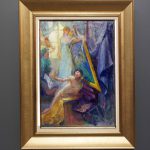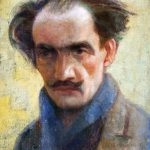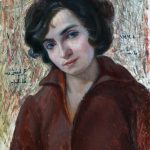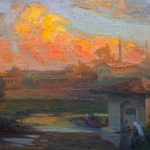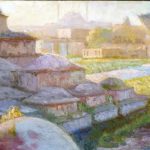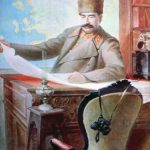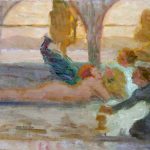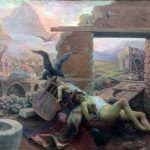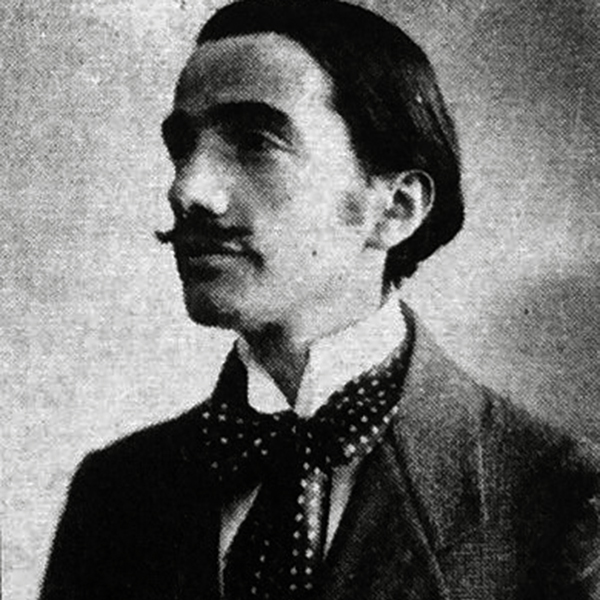
Who is Hüseyin Avni Lifij? (1886 Ladik – 1927 Istanbul
The large-scale compositions of Hüseyin Avni Lifij, a figure painter, have a symbolic structure. Using color and light skillfully, Hüseyin Avni Lifij creates a poetic, mysterious atmosphere with his unique light. We guess that you will enjoy reading the artist’s life story;
The artist’s family migrated from the Kuban region of the Caucasus during the 1877-1878 Ottoman-Russian War and first settled in Samsun. H.Avni Lifij was born in the village of Karaaptalsultan in Ladik district of Samsun.
He entered Istanbul Fatih Aşıkpaşa Neighborhood School in 1893 and finished his primary education in 1896, taking special interest in painting and music lessons. He completed his secondary education, which he started in 1896, at the “Numune-i Terakki Mektebi” in Şehzadebaşı in 1898; He tried to learn French, the prevailing language of the period, by taking lessons from a high school graduate. He was not sent to school for two years because he fell ill in the same year. In 1901, he took a job at the Railways Directorate of the Ottoman Ministry of Public Works. He attended Alyans Israelite school for a short time to improve his French. He also took private French lessons from İskender Ferit Bey. He continued his French lessons until 1904. He attended the Civil School of Medicine to learn anatomy, and the physics and chemistry classes of the Pharmacist School as an audience student to learn the painting technique.
In 1906, when French teacher İskender Ferit and his new acquaintance, Henri Prost, suggested that he take his paintings to Museum Director Osman Hamdi Bey, he did as they said. Osman Hamdi Bey, who liked his painting Self-Portrait with a Pipe, asked him to show him his paintings from now on. In 1908, the list of student candidates that Osman Hamdi Bey wanted to send to Paris, including Hüseyin Avni Lifij, and the painting “Self-Portrait with a Pipe” were presented to Abdülmecid Efendi.
In 1909, he went to Paris and received a currency monitoring certificate from "I'Ecole Nationale Speciale des Beaux-Art" and started painting at the Fernand Cormon Workshop. He made friends with painters Guillonnet and Andre Lecomte Du Noüy and continued his workshops in his free time. When he was called back to Istanbul in 1912, he worked as an art teacher at Istanbul Sultanisi (Istanbul Boys' High School). In 1915, she worked as a French teacher at Kandili İnas Sultanisi (Kandilli Girls' High School). The collection at the Louvre Museum in Paris, including the copy of Luca Giordano's painting "Mars and Venus" made by Lifij, was collected at the School of Fine Arts; It was exhibited in October 1915. In the spring of 1916, he participated in the 1st Galatasaray Students' Dormitory Painting Exhibition with two of his paintings. In the autumn of 1917, he participated in the "War Paintings and Others" Exhibition, which opened at the Galatasaray Residence Hall in Istanbul, with 20 paintings. He participated in the "War Paintings and Others Exhibition" exhibited in Vienna in 1918 with 18 paintings. 56 paintings belonging to the government, including five works of the artist, were included in the "Collection of Paintings" in accordance with the certificate of the Board of Education dated 12.3.1921. He participated in the 4th Galatasaray Painting Exhibition organized by the Turkish Painters Association with three paintings, and in the exhibition at the Free "Painting Workshop" established in the same year, with 7 pochads and 1 sketch.
Among the teachers who went to Bursa to meet Mustafa Kemal in October 1922, there were the artist, his wife Harika, and his wife's brother, the sculptor Nijad. Mustafa Kemal took Avni Lifij to Ankara and hosted Erkan in Harbiye for four months. During his first visit to Ankara, the artist painted the portrait of Marshal Fevzi Çakmak.
On his return to Ankara, he started the preparations for the "Karagün" and "Akgün" paintings. At the end of a year, the composition in question was applied to the canvas.
In 1924, he was appointed as the Alisi Decorative Arts teacher at Sanayi-i Nefise Mektebi. He remained in office as the Alisi Tezyiniye Instructor of Sanayi-i Nefise Mektebi until his death. He created the painting "Mareşal Fevzi Çakmak is on the job". (At the Istanbul Painting and Sculpture Museum), but without seeing the first graduates of the department; He passed away in his room in Harikzedegan Apartment in Laleli on June 2, 1927, when he was only 41 years old. His grave is located on Pierre Loti Hill in the Eyüp district of Istanbul.
Lifij, a figure painter, has a symbolic structure in his large-scale compositions, other than his pochads. Using color and light skillfully, the artist creates a poetic, mysterious atmosphere with his unique light. Showing the artist's moment of inspiration, The Workshop is a symbolic/romantic painting.
Avni Lifij painted villages outside Istanbul, village life and nature at different times of the day. Lifij, who is also interested in photography, uses a kind of fragment aesthetics, enlarging and shrinking his subjects, playing with their clarity, sometimes turning them into a stain.
Some of his works
1903 Night of Power, 1907 Self Portrait, 1907 Harmony, 1912 Landscape from Yeşilköy, 1913 Development, Istanbul Painting and Sculpture Museum, 1916 Allegory, Istanbul Painting and Sculpture Museum, 1924 Karagün, 1924 Akgün, Tomb Gate, Izmir Painting and Sculpture Museum, Istanbul Morning in , Houses (Türkiye İş Bankası collection)
